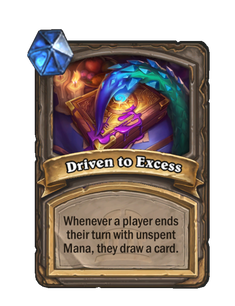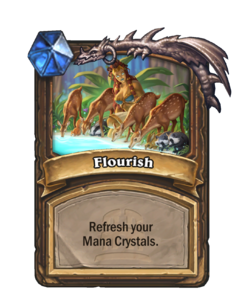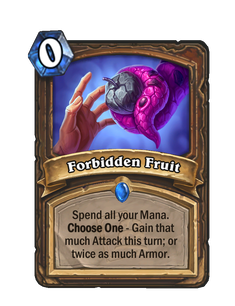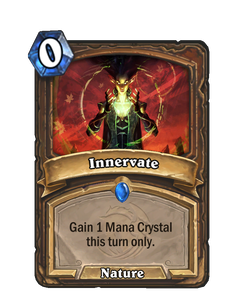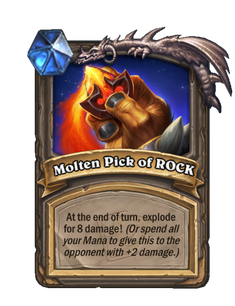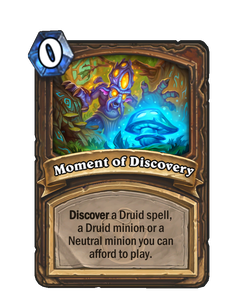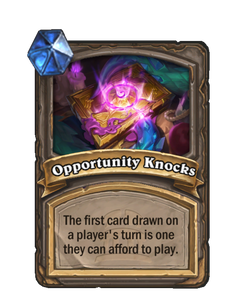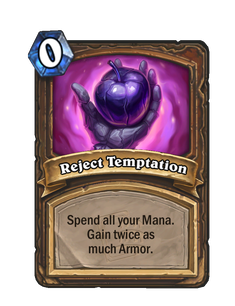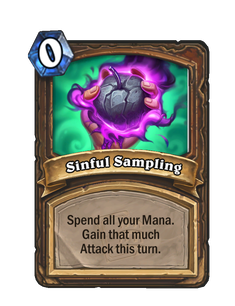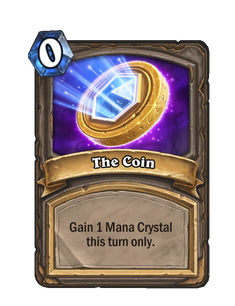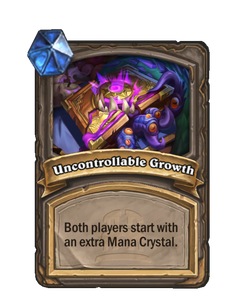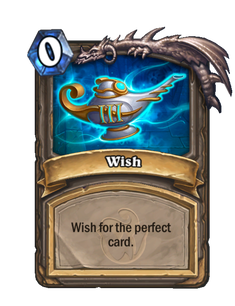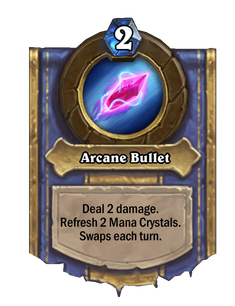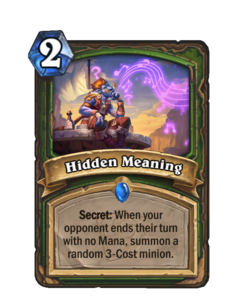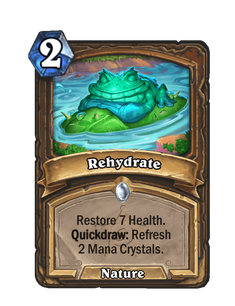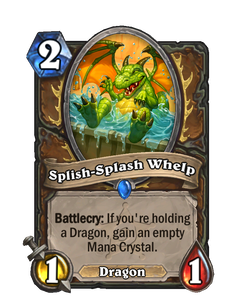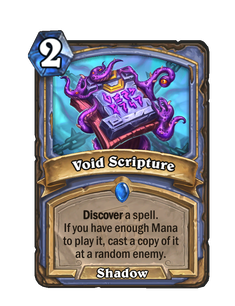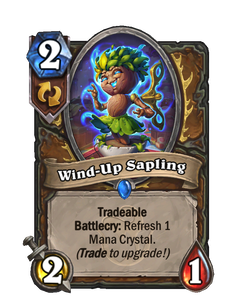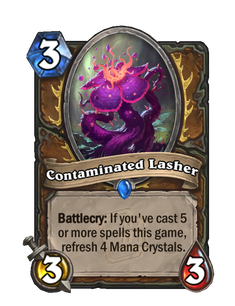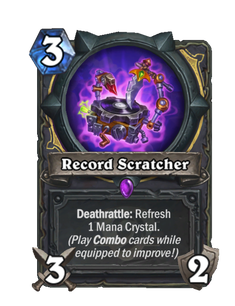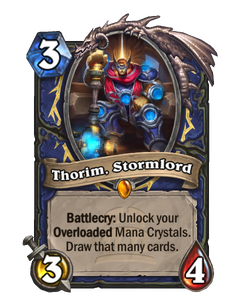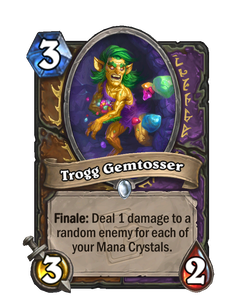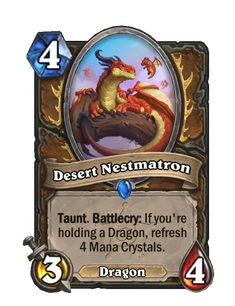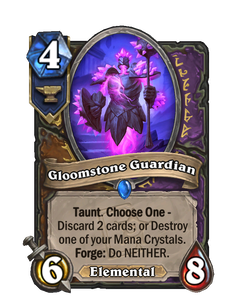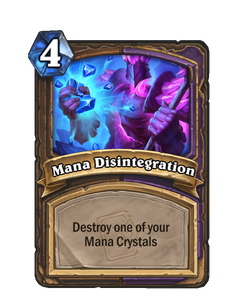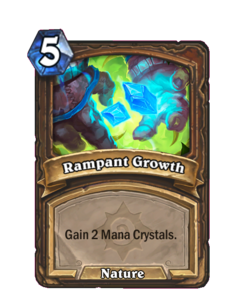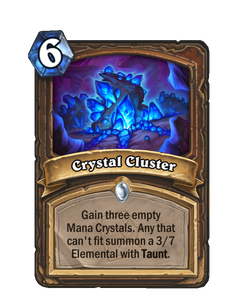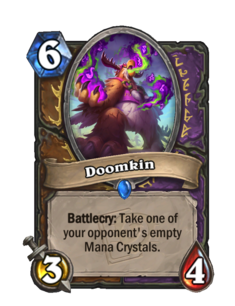Mana
Mana is the resource used in Hearthstone to play cards and use Hero Powers, each of which has a mana cost that must be paid to use it. The supply of mana is represented by Mana Crystals, displayed at the bottom right of the screen. This supply automatically increases and refills each turn, although certain cards can also affect it. Mana is the only resource used in Hearthstone, and is the primary limiting factor on the play of cards.
A player's mana is displayed in-game with two numbers:
- The first is the number of available mana (also referred to as current mana, or simply mana).
- The second is the number of permanent Mana Crystals (also referred to as maximum mana).
On the right of these numbers, the statuses of Mana Crystals are displayed visually with different icons: filled / empty / Overloaded / pending Overloaded.
Mana Crystals[edit | edit source]
Mana Crystals are usually permanent, although some effects explicitly grant temporary Mana Crystals for that turn only.
Permanent Mana Crystals can be in one of the following statuses:
- filled Mana Crystals (displayed with a glowing blue icon) increase also the amount of available mana, and thus can be used to pay mana costs.
- empty Mana Crystals (displayed with a darkened blue icon) cannot be used to pay mana costs until they are refilled.
- Overloaded Mana Crystals (displayed with a gray padlock icon) cannot be used to pay mana costs until they are unlocked and refilled.
Effects that give Mana Crystals for "this turn only" (e.g. ![]() Innervate,
Innervate, ![]() The Coin) grant temporary Mana Crystals, which increase available mana for that turn but do not affect maximum mana.
The Coin) grant temporary Mana Crystals, which increase available mana for that turn but do not affect maximum mana.
- Temporary mana can make the player go above their current maximum mana. For example, playing The Coin while the player's maximum mana is 10 will make their mana go to 11/10.
- Visually, temporary Mana Crystals are displayed to the right of permanent Mana Crystals or, if there is no room, they appear to refill existing empty Mana Crystals.
- The mana in temporary Mana Crystals is always spent before the mana in permanent Crystals. When their mana is spent, temporary Mana Crystals disappear rather than becoming empty.
- Temporary Mana Crystals cannot be Overloaded nor pending Overloaded, and are not destroyed by abilities that destroy Mana Crystals.[1]
Maximum mana[edit | edit source]
The number of permanent Mana Crystals, called maximum mana, is displayed by the second number of the mana counter at the bottom right of the screen.
Players begin the game with 0 permanent Mana Crystals.
Permanent Mana Crystals can be gained in the following ways, up to a default maximum of 10:
- At the start of each player's turn (including the first turn of the game), that player gains a new permanent Mana Crystal (and all of their non-Overloaded Mana Crystals are refilled).
- Some effects (e.g.
 Wild Growth,
Wild Growth,  Mire Keeper) explicitly give empty Mana Crystals, thus increasing maximum mana but not available mana.
Mire Keeper) explicitly give empty Mana Crystals, thus increasing maximum mana but not available mana. - Other effects that give Mana Crystals to a player (e.g.
 Nourish,
Nourish,  Astral Communion) grant filled Mana Crystals, thus increasing both available and maximum mana accordingly.
Astral Communion) grant filled Mana Crystals, thus increasing both available and maximum mana accordingly. - A player's default maximum mana crystals are 10. This can be increased by some cards, e.g.
 Wildheart Guff and
Wildheart Guff and  Audio Amplifier, after which the same rules apply but for the new maximum mana.
Audio Amplifier, after which the same rules apply but for the new maximum mana.
Effects that destroy Mana Crystals (e.g. ![]() Felguard,
Felguard, ![]() Blastcrystal Potion) permanently destroy permanent Mana Crystals, starting from empty ones, decreasing maximum mana up to a minimum of 0.
Blastcrystal Potion) permanently destroy permanent Mana Crystals, starting from empty ones, decreasing maximum mana up to a minimum of 0.
- If a player is forced to lose a filled Mana Crystal (because all of their permanent Mana Crystals are filled), their available mana will be reduced accordingly for the current turn too. Otherwise, their available mana is not reduced for the current turn, but only for subsequent ones.
- A player can never have less than 0 maximum mana[2].
- Example: If a player repeatedly plays
 Felguard to destroy all of their Mana Crystals[3] and then plays another Felguard, nothing happens.
Felguard to destroy all of their Mana Crystals[3] and then plays another Felguard, nothing happens. - Example: A player that has one of their Mana Crystals destroyed will have one less mana each turn until they reach 10 Mana Crystals. Thus, if that player was already at 10 Mana Crystals, they will lose a Mana Crystal but simply regain it at the beginning of their next turn.
Available mana[edit | edit source]
The number of currently filled Mana Crystals, called available mana or current mana, is displayed by the first number of the mana counter at the bottom right of the screen and represents the amount of mana that is still available for the player to use cards and Hero Powers that turn.
Available mana can be increased in the following ways, up to a default maximum of 10:
- At the start of each player's turn all of their non-Overloaded Mana Crystals are refilled, increasing available mana accordingly. (This means that mana left unspent by the end of the turn is essentially wasted, since it is refilled anyway at the beginning of the next turn.)
- Effects that give Mana Crystals for "this turn only" (e.g.
 Innervate,
Innervate,  The Coin) grant temporary Mana Crystals, which increase available mana for that turn.
The Coin) grant temporary Mana Crystals, which increase available mana for that turn. - Effects that give permanent filled Mana Crystals to a player (e.g.
 Nourish,
Nourish,  Astral Communion) increase both available and maximum mana accordingly.
Astral Communion) increase both available and maximum mana accordingly. - Cards that refresh Mana refill all of their controller's non-Overloaded Mana Crystals, increasing available mana accordingly.
- Cards like
 Lava Shock and
Lava Shock and  Eternal Sentinel unlock and refill all currently Overloaded Mana Crystals, increasing available mana accordingly, and remove all currently pending Overloaded mana.
Eternal Sentinel unlock and refill all currently Overloaded Mana Crystals, increasing available mana accordingly, and remove all currently pending Overloaded mana. - After Patch 29.0.0.195635, temporary mana, such as from
 Innervate can make the player temporarily go above their maximum mana.
Innervate can make the player temporarily go above their maximum mana. - Effects that grant one or more permanent Mana Crystals and have no other effects (e.g.
 Wild Growth,
Wild Growth,  Overgrowth) while the player already has their maximum permanent Mana Crystals generate an Excess Mana for the player instead.
Overgrowth) while the player already has their maximum permanent Mana Crystals generate an Excess Mana for the player instead.
Available mana can be reduced in the following ways:
- When a player spends mana to play cards or use Hero Powers, their available mana is reduced accordingly. This is the most frequent way a players' available mana is reduced, up to the beginning of their next turn when their Mana Crystals are refilled and they can spend their mana again.
- Each card and Hero Power has a specific mana cost, displayed as a number inside a blue crystal in the upper left corner of each card and at the top of each Hero Power, which represents the amount of mana that must be expended in order to play that card or use that Hero Power. Some effects can decrease or increase these mana costs: for a list of such effects and how they interact with each other, see Mana cost.
- Cards can be played and Hero Powers can be used only if their mana cost can be paid. Note that the mana cost must be paid before any card effects are taken into account, so cards like
 Lava Shock or
Lava Shock or  Nourish cannot be cast if the player has less than the stated mana cost, even if the card itself would free up enough mana.
Nourish cannot be cast if the player has less than the stated mana cost, even if the card itself would free up enough mana. - Mana spent is taken from temporary Mana Crystals first (which disappear after being used), and any exceeding cost is then taken from permanent Mana Crystals (which become empty).
- Effects that destroy Mana Crystals (e.g.
 Felguard,
Felguard,  Blastcrystal Potion) reduce available mana only if they are forced to destroy filled Mana Crystals.
Blastcrystal Potion) reduce available mana only if they are forced to destroy filled Mana Crystals. - The spend mana ability consumes all the player's available mana as part of the card's effect, producing an effect proportional to the amount spent. Cards that spend mana can be played even when there is no mana left to consume (although in that case the ability will simply have no additional effect).
- Cards with Overload that are played from the hand reduce the amount of mana available the next turn by the stated amount. More precisely, playing a card with Overload causes the stated amount of Mana Crystals to become pending Overloaded (a padlock icon appears beneath a permanent Mana Crystal for each point Overload), and at the start of the next turn that Mana Crystals will become Overloaded: the padlocks will move up and block out the player's Mana Crystals, effectively preventing them from being refilled and used for that turn.
- A player's current and/or pending Overloaded Mana Crystals has no upper limit. For example, a player can Overload more mana than they will have the next turn: even if the user interface will only display Overload equal to the player's maximum mana, the excess will still be registered and will affect mana-generating effects like
 The Coin.[4]. Once the Overload has been matched, any further mana generated will be usable by the player, and will be reflected in the mana counter.
The Coin.[4]. Once the Overload has been matched, any further mana generated will be usable by the player, and will be reflected in the mana counter. - Overload affects available mana for the next turn only, even if it is greater than that turn's maximum mana: current Overload will disappear (regardless of its amount) at the beginning of the player's next turn, when it is substituted by previous turn's pending Overload.
- Example: If a player plays two Dust Devils on turn two, on the next turn they will have 4 Overloaded mana despite having only 3 Mana Crystals: this mana deficit will not carry over to subsequent turns, thereby allowing the player to avoid paying that part of the Overload cost at all.
- Overloaded and pending Overloaded mana are not displayed for the opponent: players trying to estimate the opponent's available mana next turn can use the history to check the cards played that turn.
- A player's current and/or pending Overloaded Mana Crystals has no upper limit. For example, a player can Overload more mana than they will have the next turn: even if the user interface will only display Overload equal to the player's maximum mana, the excess will still be registered and will affect mana-generating effects like
- Available mana has no lower limit and thus, with enough Overload, "actual" available mana can be negative: although the game interface simply displays negative available mana as 0 and gives no sign at all that excess Overload remains, the excess will still be registered, and will counter mana generation through effects like
 Innervate.
Innervate. - However, no amount of Overload will prevent the player from playing 0-Cost cards:[4] since these cards cost no mana, the player's current mana total is irrelevant.
Strategy[edit | edit source]
- Main article: Mana curve
The limited but slowly-increasing supply of mana serves to delay and add pace to the game, preventing players from simply playing their most powerful cards on round one. It also crafts the game into distinct phases, with higher-value cards only becoming playable in later rounds. The increase of available mana over the course of a match is referred to as the mana curve, and is a key strategic concept, both during play and in deck building.
As one of the key limiting resources in the game, effective mana management is essential for achieving victory in Hearthstone. While generally it is ideal to make use of all available mana each turn to maintain tempo, in practice it is sometimes wiser to hold back cards until the right time, especially if planning a combo. While this may lead to mana being 'wasted', taking a more cautious approach to card playing can win games. Hero Powers, while intentionally mana-inefficient, may be helpful for making use of mana every turn without consuming cards.
The mana cost of a card determines which round it will become available to play, as well as which cards it can be used in combination with. This concept is used in deck building to ensure viable options each turn, and can also be used to predict which cards may be played on certain rounds, such as ![]() Mind Control generally only becoming playable from round 10 onwards.
Mind Control generally only becoming playable from round 10 onwards.
Related cards[edit | edit source]
- For Wild format listings, see Mana/Wild format.
The following cards have effects that specifically alter a player's available and/or maximum mana (these effects are most commonly found in druid cards). Not listed here are cards with Overload (found only in shaman cards), which reduce available mana for the next turn (see Overload for a list).
For a list of cards that modify mana costs rather than available/maximum mana, see Mana cost instead.
Trivia[edit | edit source]
- Unlike in many other games, including World of Warcraft, in Hearthstone mana is apparently not an arcane or purely magical power, and can be wielded by heroes of all classes. Notably, warriors, rogues and hunters normally use resources other than mana.
Patch changes[edit | edit source]
 Patch 29.0.0.195635 (2024-03-11): Temporary mana can now make you go above maximum mana. This applies to the base max mana of 10 and to any modified max mana.
Patch 29.0.0.195635 (2024-03-11): Temporary mana can now make you go above maximum mana. This applies to the base max mana of 10 and to any modified max mana.
See also[edit | edit source]
References[edit | edit source]
- ↑ Tested by User:Elekim, 15th March 2017. With
 Emperor Thaurissan to reduce costs and
Emperor Thaurissan to reduce costs and  Lorewalker Cho to get multiple Shadowsteps, I destroyed all my Mana Crystals with Felguards (going to 0/0 mana), then played
Lorewalker Cho to get multiple Shadowsteps, I destroyed all my Mana Crystals with Felguards (going to 0/0 mana), then played  The Coin (going to 1/0 mana), then played
The Coin (going to 1/0 mana), then played  Cho'gall with cost reduced to 0 in order to cast
Cho'gall with cost reduced to 0 in order to cast  Blastcrystal Potion: my mana counter was still at 1/0, and I was able to play a 1-Cost card (see Media:Mana-TempNotDestroy.jpg).
Blastcrystal Potion: my mana counter was still at 1/0, and I was able to play a 1-Cost card (see Media:Mana-TempNotDestroy.jpg).
- ↑ BuB ChaCha (2015-02-25). The Coin vs. Felguard|幸運幣vs.惡魔守衛.
- ↑ BuB ChaCha (2015-02-17). Miracle Warlock:(1)Mana vs.Felguard|(1)法力水晶vs.惡魔守衛.
- ↑ 4.0 4.1 Tested by User:Taohinton, 2014-02-19. Tested twice: Played
 Dust Devil x 2 on turn 2. On turn 3 the mana bar showed 0/3 mana. Played
Dust Devil x 2 on turn 2. On turn 3 the mana bar showed 0/3 mana. Played  The Coin and a fourth mana crystal appeared, without a padlock. However, the total remained at 0/3, and I was unable to play any 1 mana cards
The Coin and a fourth mana crystal appeared, without a padlock. However, the total remained at 0/3, and I was unable to play any 1 mana cards
- Gameplay elements


